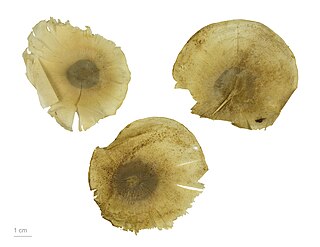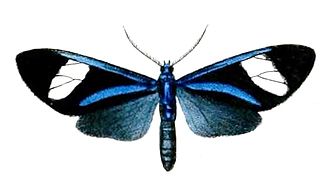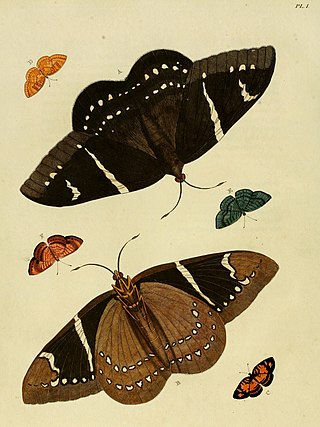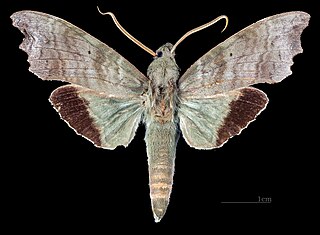
Pouteria is a genus of flowering trees in the gutta-percha family, Sapotaceae. The genus is widespread throughout the tropical Americas, with outlier species in Cameroon and Malesia. It includes the canistel, the mamey sapote, and the lucuma. Commonly, this genus is known as pouteria trees, or in some cases, eggfruits.

Aspidosperma is a genus of flowering plant in the family Apocynaceae, first described as a genus in 1824. It is native to South America, Central America, southern Mexico, and the West Indies.

Euagra is a genus of moths in the subfamily Arctiinae. The genus was erected by Francis Walker in 1854.

Psychophasma is a monotypic moth genus in the family Erebidae erected by Arthur Gardiner Butler in 1878. Its only species, Psychophasma erosa, was first described by Gottlieb August Wilhelm Herrich-Schäffer in 1858. It is found in Guatemala, Costa Rica, Mexico, Nicaragua, Panama, Ecuador, Venezuela, Suriname, French Guiana, Guyana, Brazil, Bolivia, Colombia and Peru.

Telchin licus, the banana stem borer, is a moth of the Castniidae family. It is native to South America, where it is found from Colombia, Venezuela and the Guianas, throughout the Amazon basin in Brazil and Peru. It has also been recorded as an introduced species in Hawaii.

Athis inca is a moth of the Castniidae family. It is found from Mexico to Costa Rica.
Ircila is a monotypic moth genus in the family Castniidae described by Constant Vincent Houlbert in 1918. Its single species, Ircila hecacte, was first described by Gottlieb August Wilhelm Herrich-Schäffer in 1854. It is known from Haiti.

Amauta is a genus of moths within the family Castniidae. It was described by Constant Vincent Houlbert in 1918.

Eupalamides is a genus of moths within the family Castniidae. It was described by Constant Vincent Houlbert in 1918.

Aleuron chloroptera is a moth of the family Sphingidae. It was described by Maximilian Perty in 1833, and is known from southern Mexico, Brazil, Belize, Guatemala, Nicaragua, Costa Rica, Colombia, Peru, Bolivia, Venezuela, Guyana, Suriname, French Guiana, Paraguay, Argentina and Ecuador. It is probably also present in Uruguay, Honduras, El Salvador and Panama.

William Schaus was an American entomologist who became known for his major contribution to the knowledge and description of new species of the Neotropical Lepidoptera.

Xanthocastnia is a genus of moths within the family Castniidae containing only one species, Xanthocastnia evalthe, which is widespread in the Neotropical realm, ranging from southern Mexico to southern Brazil.

Amauta papilionaris is a moth in the Castniidae family. It is found in Colombia, Venezuela, Peru, Bolivia, Ecuador and Panama.
Castnius pelasgus is a moth in the Castniidae family. It is found in Suriname, Peru and Amazonas.
Castnia invaria is a moth in the family Castniidae. It is found in South America.
Athis palatinus is a moth in the Castniidae family. It is found from Mexico south to Peru and Brazil.
Athis rutila is a moth in the Castniidae family. It is found in Brazil, Venezuela, French Guiana and Peru.

Prepona laertes, the shaded-blue leafwing or Laertes prepona, is a butterfly of the family Nymphalidae. It is found in large parts of Central and South America.
Eupalamides cyparissias is a moth in the Castniidae family. It is widespread in the Amazon basin including Peru, Colombia, Ecuador, Venezuela, Brazil, the Guianas, Suriname and north to Panama.
Haemonides cronis is a moth in the Castniidae family. It is found in Mexico, Trinidad, Suriname, French Guiana, Brazil and Peru.













